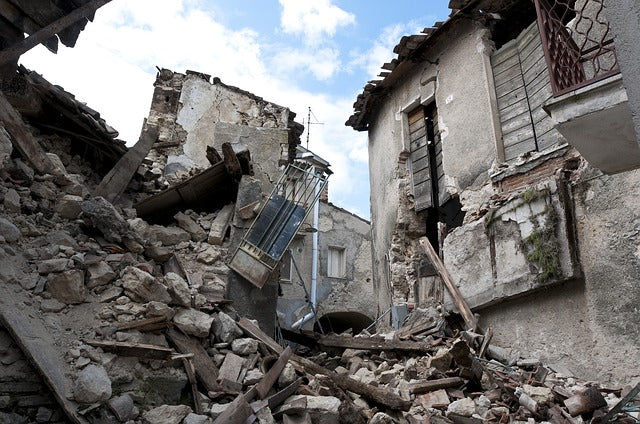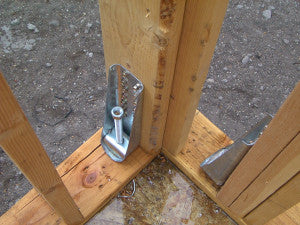I'm not sure where you live, but being born and raised in Southern California - I know one thing;
earthquakes can be really dangerous, and even more so than other
natural disasters as they're highly unpredictable. Sometimes you need to
prepare beyond a bug out bag, and in this article, I'm going to show you how to prepare your own home in case such a disaster does strike.

As you probably know, the weather department can predict and warn people against certain types of natural disasters such as:
However, even with advanced technology, we don’t yet have a fool-proof system for determining the locations and magnitudes of upcoming earthquakes.
Scientists do have a general idea on which areas are most prone to earthquakes – but unfortunately, they can't tell the exact time when the catastrophe will occur.
So, the only way to minimize loss of life and property during a quake is to
prepare beforehand.
Here are 5 easy tips to prepare your property for seismic activity:
1) Get your home insured against earthquakes:
This step is especially crucial if your region is highly susceptible to quakes.
Depending upon the magnitude, a quake can cause hundreds of thousands (even millions) of dollars’ worth of damage to a property.
If disaster does strike (scientists suggest that someday, it sure will), your insurance can be an absolute blessing. It can help you to rebuild your home or buy a new home and continue to live life normally. Many insurance policies do not provide earthquake coverage but it may be available as an optional extra.
If you already have a policy in place, upgrade it so that it covers earthquake damages as well. All the information mentioned in this article can't help you that much if you don't have (or don’t plan to get) earthquake insurance.
Please don’t make the mistake of ignoring this step.
Take a look at the places that have been affected by hurricane Katrina – many people have not been able to rebuild their properties due to lack of funds. Unfortunately, they are forced to live in run-down homes and temporary shelters even years after the cataclysmic event shook their world forever.
2) Make sure that your home has a strong foundation:
Most new homes are built upon a foundation but many older properties are held in place simply by their own weight. In order for your home to be able to withstand tremors, it must be fixed firmly to the ground – otherwise, it will wobble, crack, and crumble. Also, the walls and roof should be attached strongly to each other. Here are a couple of ways to reinforce the structural integrity of your house:
-
[caption id="attachment_21426" align="alignright" width="300"]
 Anchor bolts[/caption]
Add anchor bolts between the house and its foundation. Steel plates will also do the job. This procedure is not as expensive as you think. Spend a few hundred dollars and prevent your home from crumbling, being overturned, or sliding off during a quake.
Anchor bolts[/caption]
Add anchor bolts between the house and its foundation. Steel plates will also do the job. This procedure is not as expensive as you think. Spend a few hundred dollars and prevent your home from crumbling, being overturned, or sliding off during a quake.
- Fix cracks in your walls or in the roof (if any).
- Brace the cripple wall of your home. A house’s cripple wall is usually its weakest part. (This is the wall between the foundation and the first floor.)
- Reinforce chimneys and other attached structures such as garages, joint sheds, etc.
3) Use flexible connectors for gas and water to prevent leaks.
Gas leaks can be several times more dangerous than the earthquake itself. Invest in an automatic shut-off device (activates upon breakage of connectors) or install a main switch to turn off gas and power supply completely. If your home has any plumbing or electrical faults, get them repaired as soon as possible.
4) Many people ignore this completely – Understand that glass becomes your sworn enemy during natural disasters.
Pieces of broken glass get strewn about and may cause serious wounds and bleeding. You can easily prevent this by installing a clear, shatterproof film over glass surfaces.
This way, even if the glass does break – it will be held together by the film.
Shatterproof films are not expensive at all – they can even be purchased online for a few dollars.
Installation is quite easy and requires only a few common tools. Not only do the films prevent shattering, but they also keep out harmful UV rays. Sounds like the perfect weekend project, doesn’t it?
5) Pay attention to the layout of furniture within your home:
Heavy objects such as dressers, water heaters, etc. should not be left hanging or unsecured. Place them close to the ground and anchor them to the wall with bolts. Don’t hang paintings, glass lamps, chandeliers, and other decorative pieces directly above beds and sofas. All cupboards should have safety latches to prevent contents from spilling out. Also, don’t put pesticides, cleaning agents, and other chemicals on top of wardrobes and on high shelves. Think twice before investing in a glass-top table. You should have a sturdy piece of furniture to hide under during an earthquake – a strong wood top table or bed is ideal. A glass-top table may look nice, but in an emergency, it's pretty useless.
If you’re buying or renting a house, make sure that it complies with the local earthquake regulations. Last but not the least, buy a
battery operated radio. I know it's a bit old fashioned but it may be your only source for receiving communication during a quake as power lines and mobile networks are usually down.
____
About the Author: J.D. Phillips Runs
SurvivalCrackas.com and lives with his family in Southern California. You can follow him on
Facebook and download his Guide
How to Build the Ultimate Disaster Kit free of charge from his website, linked above!

 As you probably know, the weather department can predict and warn people against certain types of natural disasters such as:
As you probably know, the weather department can predict and warn people against certain types of natural disasters such as:
 Anchor bolts[/caption]
Add anchor bolts between the house and its foundation. Steel plates will also do the job. This procedure is not as expensive as you think. Spend a few hundred dollars and prevent your home from crumbling, being overturned, or sliding off during a quake.
Anchor bolts[/caption]
Add anchor bolts between the house and its foundation. Steel plates will also do the job. This procedure is not as expensive as you think. Spend a few hundred dollars and prevent your home from crumbling, being overturned, or sliding off during a quake.


1 comment
Cristine
The spacer? a?e positioned behind the b?acket? to
ensur? the parallel distance in between all four braces will certainly be the same.